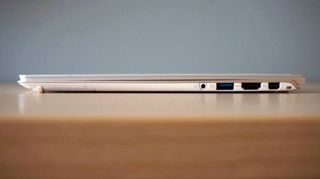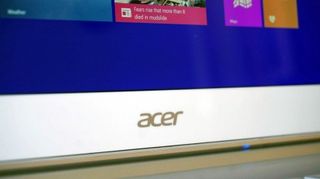Why you can trust TechRadar
There's no denying that the Acer Aspire S7 is one of the most attractive Ultrabooks on the market today, and this update changes little in that regard. You're still looking at an all-aluminum frame, save for the Gorilla Glass lid and bezel along with the smooth, white matte plastic underside.
Acer's leading laptop measures 12.72 x 8.78 x 0.51 inches (W x D x H) and weighs 2.87 pounds, making it one of the lightest 13.3-inch laptops I've tested yet. But the competition right now is tough, and looks just as nice.
Take the 13-inch MacBook Air – arguably the inspiration for Intel's Ultrabook clean aluminum initiative – for instance: At 12.8 x 8.94 x 0.11 - 0.68 inches and 2.95 pounds, Acer's unit comes in lighter, but the difference is hardly noticeable except on a scale. The differences between the Aspire S7 and Dell XPS 13 are easier to see, with the latter coming in at 12.4 x 8.1 x 0.2 - 0.7 inches and 3.03 pounds.

Looks are important to these premium clamshells, but the true battle lies in what they're capable of, and at what cost. The Aspire S7 maintains a great aesthetic, and upgrades like quieter fans and a punchier keyboard go beyond mere style, so let's see what else Acer brought to the Aspire for 2014.
Spec sheet
This is the Acer Aspire S7 configuration sent to TechRadar:
- CPU: 1.6GHz Intel Core i5-4200U (dual-core, 3MB cache, up to 2.6GHz with Turbo Boost)
- Graphics: Intel HD Graphics 4400
- RAM: 8GB DDR3
- Screen: 13.3-inch, 2560 x 1440 IPS, LED backlit display with 10 finger multi-touch
- Storage: 128GB SSD in RAID 0
- Ports: 2 USB 3.0 (1 with power-off charging) ports, 1 HDMI, 1 combo headphone/mic jack, 1 Acer converter port, 1 SD card reader
- Connectivity: Intel Centrino Advanced-N7260, 802.11a/b/g/n WiFi with MIMO, Bluetooth 4.0, Intel Wireless Display
- Camera: 1280 x 720 HD webcam
- Weight: 2.87 pounds
- Size: 12.72 x 8.78 x 0.51 inches (W x D x H)
What you see here is the entry level configuration for an Aspire S7 with a shiny new WQHD touchscreen, and it calls for $1,399 (about £841, AU$1,536). Not quite entry level pricing, but what you're paying extra for is that display. You can score a similarly-configured model sans hyper-HD panel for $1,299.

If you wanted to go all out on an Aspire S7, it would cost you an even steeper $1,599. That would net you a punchier Core i7-4500U clocked at 1.8GHz, twice the solid-state storage capacity … and that's it – not even a bump up to 802.11ac networking. You won't get a drastically improved experience for that extra $300, so stick with the entry-level WQHD option. There are always external drives, cloud storage or streaming to better serve media nuts. Now, what can Dell and Apple offer for the same $1,400?
Aside from its 1920 x 1080 touchscreen, the XPS 13 meets the Aspire S7 part for part, right down to the Core i5-4200U chip, for $1,299. Plus, Dell does Acer one better with 802.11ac networking. The next available model goes for $1,649, which bumps it up to a Core i7 chip clocked at 1.8GHz, but still doesn't match Acer's 1440p display.
Surprisingly enough, the MacBook Air can nearly match the Aspire S7 for $50 less. You can score the same SSD capacity and beef up the processor to a 1.7GHz Core i7 (dual-core) and match the Aspire S7's 8GB of RAM for $1,349. The MacBook Air is still stuck with a rather dull 1440 x 900 panel, but also offers superior 802.11ac WiFi.

Stacked up against these two machines, there's one driving question with the new Aspire S7: do you want a laptop that can keep up with the 802.11ac router you'll buy in a few years, or one with a super sharp screen that will be ready for the next step in media? While the lack of 802.11ac WiFi here is a bummer, what you're getting in exchange is another form of future-proofing for your system. But what about how it performs now?
Joe Osborne is the Senior Technology Editor at Insider Inc. His role is to leads the technology coverage team for the Business Insider Shopping team, facilitating expert reviews, comprehensive buying guides, snap deals news and more. Previously, Joe was TechRadar's US computing editor, leading reviews of everything from gaming PCs to internal components and accessories. In his spare time, Joe is a renowned Dungeons and Dragons dungeon master – and arguably the nicest man in tech.


